[ Homepage
] [ Introduction ] [ Warning ] [ Ratings
] [ Ethics ] [ Feedback ] [ Updates
]
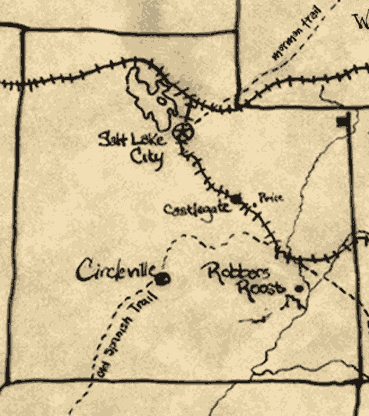 |
Robbers Roost
Outlaw Legend
Robbers
Roost was a popular outlaw hideout for over 30 years. It is located along the Outlaw Trail
in southeastern Utah. At this natural fortress fresh horses were reserved and large
quantities of weapons were cached. Butch Cassidy considered it an ideal hideout due to the
many lookout points. The original Wild Bunch corral remains in Robbers Roost, in addition
to a stone chimney, caves, and several carvings. Due to the difficult terrain, maze of
canyons, and extreme heat, the Roost was never successfully penetrated by authorities. |
Robbers Roost:
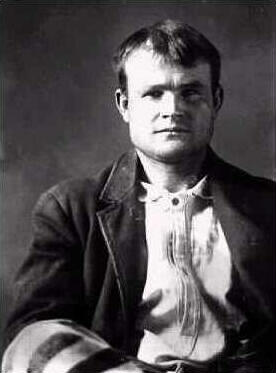 Sandwiched
between the Colorado River, Green River, and Dirty Devil River is a savage stretch of land
crisscrossed with steep-walled canyons and hidden ravines. For over 30-years this
inhospitable terrain served as a hideout for outlaws of every sort. Robbers Roost was a
stronghold of the Wild Bunch, Butch Cassidy's motley band of bank robbers, train stickup
men, and horse and cattle rustlers. Sandwiched
between the Colorado River, Green River, and Dirty Devil River is a savage stretch of land
crisscrossed with steep-walled canyons and hidden ravines. For over 30-years this
inhospitable terrain served as a hideout for outlaws of every sort. Robbers Roost was a
stronghold of the Wild Bunch, Butch Cassidy's motley band of bank robbers, train stickup
men, and horse and cattle rustlers.
The area received its colorful name
and reputation in the 1870s when Cap Brown ran stolen horses through the area. Robbers
Roost afforded hundreds of hiding spots and was difficult to penetrate. A Circleville,
Utah, native and grandson of a Mormon handcart pioneer named Robert Leroy Parker, better
known by his aliases as Butch Cassidy, began using the Roost in the 1880's to hide cattle
that he rustled.
Robbers Roost was one of several
hideouts along what became known as the Outlaw Trail. Brown's Hole, a rugged canyon region
near the junction of Utah, Colorado, and Wyoming on the Green River, was another such
hideout, along with the Hole-in-the-Wall in south-central Wyoming. The three hideouts are
strung out in an approximate north-south direction and are about 200 miles apart as the
crow flies. These hideouts served as temporary refuges and semi-permanent Wild Bunch
headquarters in the 1880s, 90s, and early 1900s.
Another frequent resident of the
Roost territory was Matt Warner, born Willard E. Christiansen to the fifth wife of a
Mormon bishop in Ephraim, Utah. Warner served a cattle-rustling apprenticeship before
joining the McCarthy gang along with Cassidy. The future Wild Bunch used Robbers Roost
after a Colorado bank robbery in 1889. Members of the Wild Bunch used it again in April
1897 after they held up the Pleasant Valley Coal Company payroll. Daring robberies such as
these made the Wild Bunch notorious to some and folk heroes to others. Their hard rides
between the string of hideouts were equally impressive. The outlaws were all expert
horseman and always stressed the importance of strong, well-trained horses; often changing
mounts at the various hideouts long the outlaw trail.
The authorities, despite some
sporadic attempts and many boastful claims never successfully penetrated Robbers Roost.
Over the years the refuge gained a reputation as being impregnable, and stories about its
defenses contributed to its legend. C. L. "Gunplay" Maxwell, a small-time bandit
and want-a-be member of the Wild Bunch, wrote Utah Governor Heber M. Wells from prison
that the Roost was defended by a well-armed, 200-man gang with an intricate system of
fortifications, tunnels, land mines, and a vast storehouse of supplies and ammunition.
This letter fueled the reputation of the Roost. Few lawmen cared to enter such supposedly
dangerous ground. The Roost was largely abandoned as an outlaw hangout after 1902 when
Butch Cassidy and the Sundance Kid departed for South America.
During
prohibition the Robbers Roost area saw one last surge of illegal activity. A number of
unlawful whiskey stills were erected at springs in the clandestine canyons. Moonshine was
often the only way to earn cash during the depression years. Several of the canyons in the
Roost still contain evidence of the illegal stills.
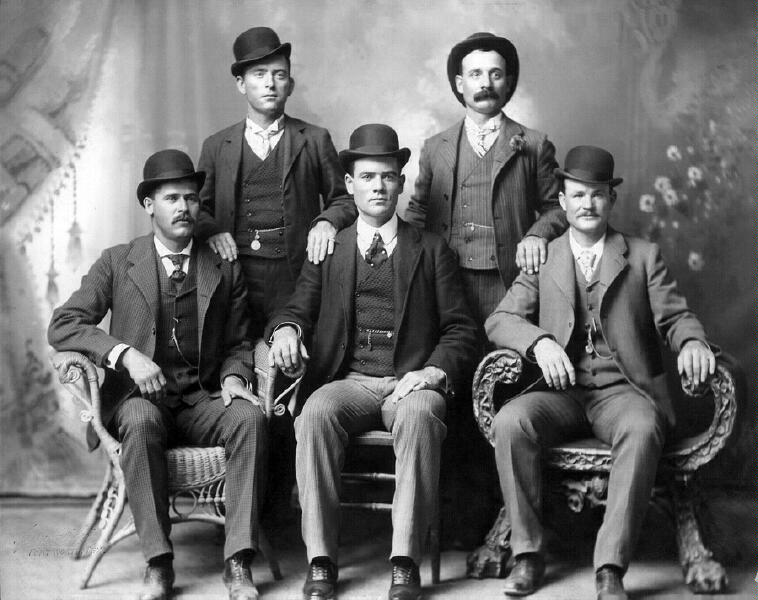 A
turn-of-the-century photograph of the "Wild Bunch". From left: Henry Longabaugh,
alias the Sundance Kid; William Carver, alias News Carver; Ben Kilpatrick, alias the Tall
Texan; Harvey Logan, alias Kid Curry; and Robert LeRoy Parker, alias Butch Cassidy.
|
Butch Cassidy:
Of all Western outlaws, none are
more fondly remembered in story and folklore than the "Robin Hood of the West,"
Butch Cassidy - the alias of Robert LeRoy Parker. Parker was born 15 April 1866 in Beaver,
Utah, and was raised by Mormon pioneer parents on a ranch near Circleville, Utah. While a
teenager, Parker fell under the influence of an old rustler named Mike Cassidy. Parker
soon left home to ride the outlaw trail.
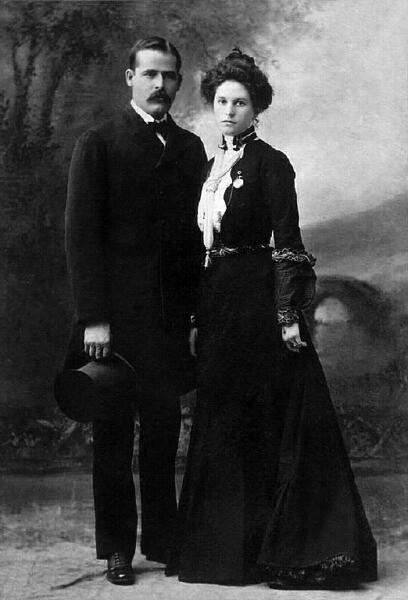 For
the first several years after leaving home, Parker rode the fringe between being an outlaw
and a migrant cowboy. He worked several ranches as well as one time in a butcher shop at
Rock Springs, Wyoming, from which he took the name "Butch"; and to not bring
shame upon honest parents, he added the name Cassidy, most likely in respect for his old
mentor. Moving from rustler, for which he served a two-year stint in a Wyoming jail from
1894 to 1896, to master planner of the robbery of trains, banks, and mine payrolls came
naturally for Cassidy. With his quick wit and native charm, coupled with his fearlessness
and bravery, he never lacked for willing companions to assist in his plans. By 1896 his
gang dubbed themselves the "Wild Bunch." This gang consisted of several
notorious Western outlaws including Harry Longabaugh, known as the Sundance Kid; Harvey
Logan, alias Kid Curry; Ben Kilpatrick, the Tall Texan; Harry Tracy, Elzy Lay, who was
Butch's best friend, and several others. Operating around the turn of the century, Cassidy
and his partners put together the longest sequence of successful bank and train robberies
in the history of the American West. For
the first several years after leaving home, Parker rode the fringe between being an outlaw
and a migrant cowboy. He worked several ranches as well as one time in a butcher shop at
Rock Springs, Wyoming, from which he took the name "Butch"; and to not bring
shame upon honest parents, he added the name Cassidy, most likely in respect for his old
mentor. Moving from rustler, for which he served a two-year stint in a Wyoming jail from
1894 to 1896, to master planner of the robbery of trains, banks, and mine payrolls came
naturally for Cassidy. With his quick wit and native charm, coupled with his fearlessness
and bravery, he never lacked for willing companions to assist in his plans. By 1896 his
gang dubbed themselves the "Wild Bunch." This gang consisted of several
notorious Western outlaws including Harry Longabaugh, known as the Sundance Kid; Harvey
Logan, alias Kid Curry; Ben Kilpatrick, the Tall Texan; Harry Tracy, Elzy Lay, who was
Butch's best friend, and several others. Operating around the turn of the century, Cassidy
and his partners put together the longest sequence of successful bank and train robberies
in the history of the American West.
So many myths and legends surround
the life of Butch Cassidy that it is difficult to sort fact from fiction. One popular
story tells of the time when sixteen-year-old Harry Ogden from Escalante spent his savings
to purchase a good horse and a sixty-dollar saddle. Young Ogden went out riding along the
border of Robbers Roost in 1898, an outlaw on a jaded mount forced young Ogden off his
horse, gave the boy a quick kick in the pants, then rode off on Ogden's animal. About
three weeks later, Ogden received visitors at his home in Escalante. One of the men was
Butch Cassidy, another was the outlaw who had stolen Ogden's horse and was still riding
it. When Cassidy asked Ogden if he had lost a horse, the boy quickly identified it. Butch
Cassidy then ordered the outlaw off the horse and told him "to start walking."
He then said, "We don't have any room in this country for a man who will mistreat a
young boy."
One of the first major crimes
attributed to Cassidy is the robbery of the San Miguel Valley Bank in Telluride, on June
24, 1889. Matt Warner, Tom McCarty and Butch Cassidy got away with $20,750 by thoroughly
casing the joint first. The bandits then made their way to a Hideout in Brown's Hole,
along the Green River at the Utah-Wyoming border.
The first robbery credited to the
Wild Bunch was the August 13, 1896 holdup of a bank in Montpelier, Idaho. This robbery
showed the trappings of what would become the Wild Bunch signature holdup: a well-planned
attack. The bandits made off with $7,165.
The gang next executed perhaps
their most spectacular robbery when they stole the $8,800 payroll from the Pleasant Valley
Coal Company in Castle Gate. This was the gangs one and only major holdup in Utah. On
April 21st, 1897 the train from Salt Lake City entered Castle Gate carrying the payroll
for the Pleasant Valley Coal Company. Men carrying the money were making their way through
town towards the company office when they were robbed of the $8,800 they were carrying and
then fled to Robbers Roost, cutting telegraph wires along the trail to prevent the news of
the robbery from spreading to lawmen along their escape route.
Their next
target was the Overland Flyer train near Wilcox, Wyoming. The gang pulled the job on June
2, 1899 and pilfered $60,000. There was a shootout, but the Wild Bunch got away. Next to
experience the wrath of the Wild Bunch was a Rio Grande train near Folsom, New Mexico. On
July 11, 1899 the gang hit what would become their ultimate prize when they made off with
$70,000. The gang next robbed the Union Pacific train at Tipton, Wyoming on August 29,
1900. The gang made off with $55,000. The robbers were identified by passengers on the
train as Butch, Sundance, Kid Curry, Tall Texan, and Bill Cruzan. By this time Butch had
begun to formula a plan of going to South America. To finance the plan, he took the Wild
Bunch to Winnemucca, Nevada to rob the bank. On September 9, 1900, they stole $32,640. The
last holdup attributed to the Wild Bunch was the $65,000 robbery of the Northern Pacific
Train on July 3, 1901 near Wagner, Montana. After that, the Wild Bunch scattered.
Successfully eluding the law became
difficult as the west grew more populated and law enforcement became better organized.
When the railroads hired the Pinkerton Agency to chase down Cassidy, he and Harry
Longabaugh, along with Etta Place, went to South America and purchased a ranch in
Argentina. After a few short years of trying to make it as honest ranchers, the pair
returned to easier methods of obtaining money. After robbing banks in several South
American countries the trail of the pair grows mystical.
What happened next is the mystery
surrounding Butch Cassidy. Some claim he and Sundance were killed when trapped by Bolivian
soldiers, others emphatically believe that another pair of outlaws were killed by the
troops and that Cassidy and Longabaugh purposefully let it be known they had been killed.
The oft-told stories relate that the pair returned to the West and lived out their lives
under alias names and identities. Like many other Western figures, Butch Cassidy has
become larger than life. His name still generates fond recollections from many Utah
old-timers who love to tell stories about him. Whether he died in South America or died of
old age under one of the several identities that are attributed to him may never be fully
proven.
Sundance Kid:
Harry Longabaugh, alias
"Sundance Kid" was born in Mont Clare, Pennsylvania in 1867. Little is known of
his early life but in the late 1880s he was involved in rustling in Sundance, Wyoming.
After serving 18 months in prison he worked as a cowboy in Wyoming. Longabaugh joined up
with Harvey Logan to rob a bank at Belle Fourche, South Dakota on 27th June, 1897.
Longabaugh and Logan were captured but managed to escape from the Deadwood Jail three
months later.
In 1900 Longabaugh met Butch
Cassidy. He moved to Robbers Roost in Utah and joined what became known as the Wild Bunch
until Longabaugh escaped to South America with Butch Cassidy and Etta Place. What happen
to Longabaugh and Cassidy in South America has now become both a mystery and legend.
Kid Curry:
Harvey Logan, alias
"Kid Curry" may have been the most feared killer in the West. Soon after moving
to Wyoming in the late 1880's Logan and his brothers began rustling cattle. This soon led
to other crimes such as robbery and murder. Logan was quick to use his gun often times
with little or no provoking. Kid Curry was constantly on the run to avoid the law. On June
8, 1904 Logan and several other outlaws were trapped in a box canyon near Parachute,
Colorado. Logan was shot in the shoulder. Rather than give himself up to the lawmen he
committed suicide by shooting himself in the left temple.
News Carver:
William Carver, alias
"News Carver" robbed banks and trains for most of the 1890's with a variety of
men and gangs. Soon after the picture of the "Fort Worth Five" was taken a large
posse in Sonora, Texas shot News Carver to pieces.
The Tall Texan:
Ben Kilpatrick, alias "The
Tall Texan" was killed in 1912 during an attempted robbery of the Southern Pacific's
Sunset Flyer. A baggage car guard hit him over the head with a mallet used to crush ice
and crushed Kilpatrick's skull. Kilpatrick was only 36 when he died.
Etta Place:
Etta Place became a figure
of legendary proportion because she was a beautiful woman and the companion of Butch and
Sundance. Eyewitnesses maintain Etta and a Vernal girl named Maude Davis spent the winter
of 1896-97 in the Wild Bunch hideaway located in Robbers Roost. Etta was allegedly 20
years old at the time. She was strikingly beautiful, an excellent horsewoman and an
outstanding rifle shot.
Facts
regarding Etta are few. She became Harry Longabaugh’s (the Sundance Kid’s)
primary love interest, but her true name is not known. It is recognized that she used the
first name Ethel to sign hotel registers. As for her surname, she acquired it as the wife
(common-law or otherwise) of Sundance who often used the name Harry A. Place, an alias
borrowed from his mother, whose maiden name was Annie Place. Sundance always introduced
her to family and friends as his wife.
It is known
that Etta went to South America with Sundance and Butch, returning to the U.S. three times
during her tenure in Argentina and Bolivia. Beyond that, no one seems to know for sure
anything else about Etta Place. To this day, she remains the most perplexing member of the
Wild Bunch. Her real name, her origin, and her fate are unknown.
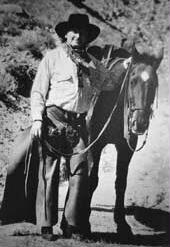 Matt Warner: Matt Warner:
Willard Erastus Christianson was
born in Ephraim, Utah in 1864 and is better known as Matt Warner, the name he took at the
outset of his bandit life. Warner was the son of a Swedish father and a German mother who
had come to Utah as converts to the Mormon Church, he had gotten into a fight with another
young man and thought he had beaten him to death. He ran off and joined a band of rustlers
to begin his life as an outlaw, he was 14-years-old. He occasionally operated out of the
Robbers Roost area. Out of all the hideout's he used over the years, Warner considered
Robbers Roost to be the most impregnable.
While on the run he married a girl
named Rose Morgan and ran a cattle ranch in Big Bend, Washington. After several robberies
he, his wife and daughter, Hayda, returned to the Diamond Mountain area of Utah. He lived
there peacefully until killing two men in a shooting scrape that earned him five years in
the Utah Sate Prison. His wife died while he was in prison. With good behavior he received
an early release. Warner remarried and settled in Carbon County, Utah. Warner ran for
public office under his real name, Willard Erastus Christianson, and lost. He had his name
officially changed to Matt Warner, the name most people knew him by, and was elected
justice of the peace and then served as a deputy sheriff. Later he was a night guard and
detective in Price, Utah. He kept his wild side happy by bootlegging. Matt died a peaceful
death, rare for an outlaw, in 1938 at the age of seventy-four.
Tom McCarty:
Tom McCarty was one of Butch
Cassidy's and Matt Warner's early mentors in banditry. Tom was Married to Matt Warner's
sister Tennie. Tom was raised on a Mormon ranch near the Utah town of Ephraim and was
known to use the Robbers Roost as a hideout.
On Mar. 30, 1889, Tom McCarty
joined Butch Cassidy and Matt Warner in robbing the First National Bank of Denver of
$20,000. Tom McCarty approached the bank president that day and stated: "Excuse me,
sir, but I just overheard a plot to rob this bank." The bank president nervously
asked: "Lord! How did you learn of this plot?" "I planned it," McCarty
said, raising his gun "Put up your hands."
On September 7, 1893, Tom, his
brother Bill, and Bill's son (Tom's nephew) Fred McCarty, held up the Farmers and
Merchants Bank of Delta, Colorado. Fred held the horses while his uncle and father entered
the bank. A. T. Blachey, the cashier began shouting for help as soon as the desperados
stated their purpose. Tom leaped over the railing and shoved his revolver in Blachey's
ribs, while Bill scooped the money into a sack. Fred rushed into the bank with news that a
crowd was gathering, and the bandits began shooting. Blachey was killed and the assistant
cashier wounded. As the McCarty's rushed outside to mount up a local hardware merchant,
Ray Simpson, heard the commotion, he grabbed a new repeating rifle and shells off his
shelves. He rushed out into the street as he loaded the rifle. As the robbers galloped
past, Simpson knocked Bill out of the saddle with a slug in the head. Fred returned to
help his dying father and was shot. After escaping a pursuing posse, Tom abandoned the
outlaw trail for a quieter life and went straight.
Some of
the information used in this article was borrowed from Jeffrey D. Nichols - Robbers' Roost
Outlaw Trail, History Blazer, August 1995.
[ Homepage ] [ Introduction ] [ Warning
] [ Ratings ] [ Ethics ] [ Feedback
] [ Updates ]
© Copyright 2000-,
Shane Burrows |
 Sandwiched
between the Colorado River, Green River, and Dirty Devil River is a savage stretch of land
crisscrossed with steep-walled canyons and hidden ravines. For over 30-years this
inhospitable terrain served as a hideout for outlaws of every sort. Robbers Roost was a
stronghold of the Wild Bunch, Butch Cassidy's motley band of bank robbers, train stickup
men, and horse and cattle rustlers.
Sandwiched
between the Colorado River, Green River, and Dirty Devil River is a savage stretch of land
crisscrossed with steep-walled canyons and hidden ravines. For over 30-years this
inhospitable terrain served as a hideout for outlaws of every sort. Robbers Roost was a
stronghold of the Wild Bunch, Butch Cassidy's motley band of bank robbers, train stickup
men, and horse and cattle rustlers.

 For
the first several years after leaving home, Parker rode the fringe between being an outlaw
and a migrant cowboy. He worked several ranches as well as one time in a butcher shop at
Rock Springs, Wyoming, from which he took the name "Butch"; and to not bring
shame upon honest parents, he added the name Cassidy, most likely in respect for his old
mentor. Moving from rustler, for which he served a two-year stint in a Wyoming jail from
1894 to 1896, to master planner of the robbery of trains, banks, and mine payrolls came
naturally for Cassidy. With his quick wit and native charm, coupled with his fearlessness
and bravery, he never lacked for willing companions to assist in his plans. By 1896 his
gang dubbed themselves the "Wild Bunch." This gang consisted of several
notorious Western outlaws including Harry Longabaugh, known as the Sundance Kid; Harvey
Logan, alias Kid Curry; Ben Kilpatrick, the Tall Texan; Harry Tracy, Elzy Lay, who was
Butch's best friend, and several others. Operating around the turn of the century, Cassidy
and his partners put together the longest sequence of successful bank and train robberies
in the history of the American West.
For
the first several years after leaving home, Parker rode the fringe between being an outlaw
and a migrant cowboy. He worked several ranches as well as one time in a butcher shop at
Rock Springs, Wyoming, from which he took the name "Butch"; and to not bring
shame upon honest parents, he added the name Cassidy, most likely in respect for his old
mentor. Moving from rustler, for which he served a two-year stint in a Wyoming jail from
1894 to 1896, to master planner of the robbery of trains, banks, and mine payrolls came
naturally for Cassidy. With his quick wit and native charm, coupled with his fearlessness
and bravery, he never lacked for willing companions to assist in his plans. By 1896 his
gang dubbed themselves the "Wild Bunch." This gang consisted of several
notorious Western outlaws including Harry Longabaugh, known as the Sundance Kid; Harvey
Logan, alias Kid Curry; Ben Kilpatrick, the Tall Texan; Harry Tracy, Elzy Lay, who was
Butch's best friend, and several others. Operating around the turn of the century, Cassidy
and his partners put together the longest sequence of successful bank and train robberies
in the history of the American West. Matt Warner:
Matt Warner: